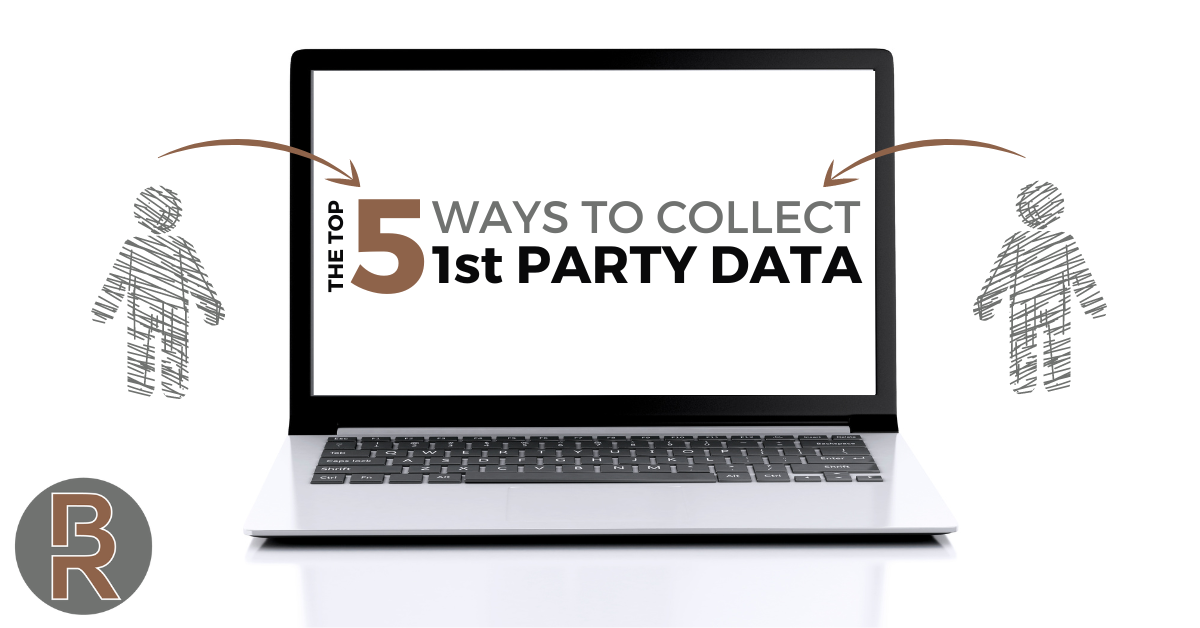
Collecting first-party data to help drive marketing campaigns has become the hot topic over the past year. Businesses have long relied upon third-party marketing data to hone in on their targeted audience and that practice has left some scrambling to find other ways to reach a more captivated buyer. As search engines have slowly blocked websites and advertising platforms from collecting third-party data on consumers, marketers are having to devise new ways to reach targeted audiences more likely to purchase the products they sell. There are many ways to build a first-party marketing list. In this article, we will discuss our top 5 ways to collect first-party data.
First-Party Data vs. Third-Party Data
Before we dive into some of the best ways to collect this data, it’s important to understand the difference between first-party and third-party marketing data, how it’s collected, and the benefits they provide to digital marketing campaigns. First-party marketing data is contact information collected directly from the customer. This information usually consists of, but is not limited to, an email address, first name, last name, and phone number. First-party data also tracks user behavior collected directly from your website or web application. This data can be uploaded to various digital advertising platforms which will match with digital user profiles allowing advertisers to directly show ads to these users not only based on their contact information, but also based on the various ways they interact with your website or web app.
In contrast, third-party data provides information about a users’ behavior across the internet on other websites they visit. This includes, but is not limited to, purchase behavior such as specific products and product categories, general interests, types of actions they take such as lead generation form fills and phone calls, and much more! Advertisers use this data to create different audience profiles and target their digital marketing efforts towards them.
Goodbye, Third-Party Cookies
In the name of user privacy, search engines and internet browsers are slowly killing off the collection of third-party cookie data leaving many advertisers scratching their heads trying to come up with alternate audience targeting practices. The best type of data to use for audience targeting is your own first-party data. Whether you’re promoting your product to those who have signed up for your email list or retargeting a list of your current or past customers, these types of audiences are going to be your most valuable as they have already expressed interest in your business.
Collecting First-Party Data
Data intelligence software provider, Claravine, compiled a list of various ways to collect first-party data but you have to provide them with your personal first-party information in order to view. We’ll save you the trouble and share our top 5 favorites.
Newsletter Sign-Ups
Most company websites provide a blog to highlight industry-related information, showcase customer success stories, and even share their involvement in community events. Companies can repurpose their blog content and create a newsletter that they periodically send via email. Most people are willing to sign up to receive a newsletter if they feel that they will benefit from its content. This is a great way to advertise promotions and offers as well.
Write Expert Content
Similar to a company blog, creating whitepapers, videos, or eBooks is a great way to collect first-party customer data. The content should go a step further than a typical blog article and provide higher value to the user in order to entice them into giving away their information. This works particularly well in the B2B sales model and can help fill the marketing funnel to target decision-makers more specifically at various stages in the purchasing process.
Discounts and Rewards Programs
Offering a membership-based rewards program will definitely help build first-party data. Consumers are always looking for ways to save money and love the feeling of getting something for “free”. A discount or rewards program will also allow you to collect more information other than just a name and an email address. The more information you can collect from customers, the more targeting capability you will have for your digital marketing campaigns.
Events
Hosting an informative industry event will not only allow the opportunity to collect information from potential customers but it will also provide you valuable face time with key decision-makers. By attending the event, you already know these buyers are serious about your product and the data you collect can be used to focus remarketing efforts or create audience profiles of individuals that share similar traits. An event doesn’t have to be 100% business-centric either. Why not host an old-fashioned cookout and label it as a community social event?
Collaborate with Other Businesses
Partnering with similar businesses can be a win-win situation for the involved parties. For example, a local HVAC company could team with a local Plumbing company and share contacts to include in each of their digital marketing efforts. Businesses can also co-host an event where interested customers can leave their contact information for future follow-up. A business might also consider influencer marketing where they team up with an individual who has a large following such as on social media or a video platform like YouTube. The leads generated by the influencer can be used as first-party marketing data.
Regardless of where your business stands with first-party data, it’s never too late to take strides towards compiling it. A great place to start is with your own customer list. This data can be uploaded to various digital marketing platforms for immediate use in campaign targeting.
At Brand Ranch Media, we love helping clients just like you come up with creative ways to utilize available marketing data to create custom audience targets. To speak with an expert, give us a call at 713-309-6380 or send us a message on our website.
